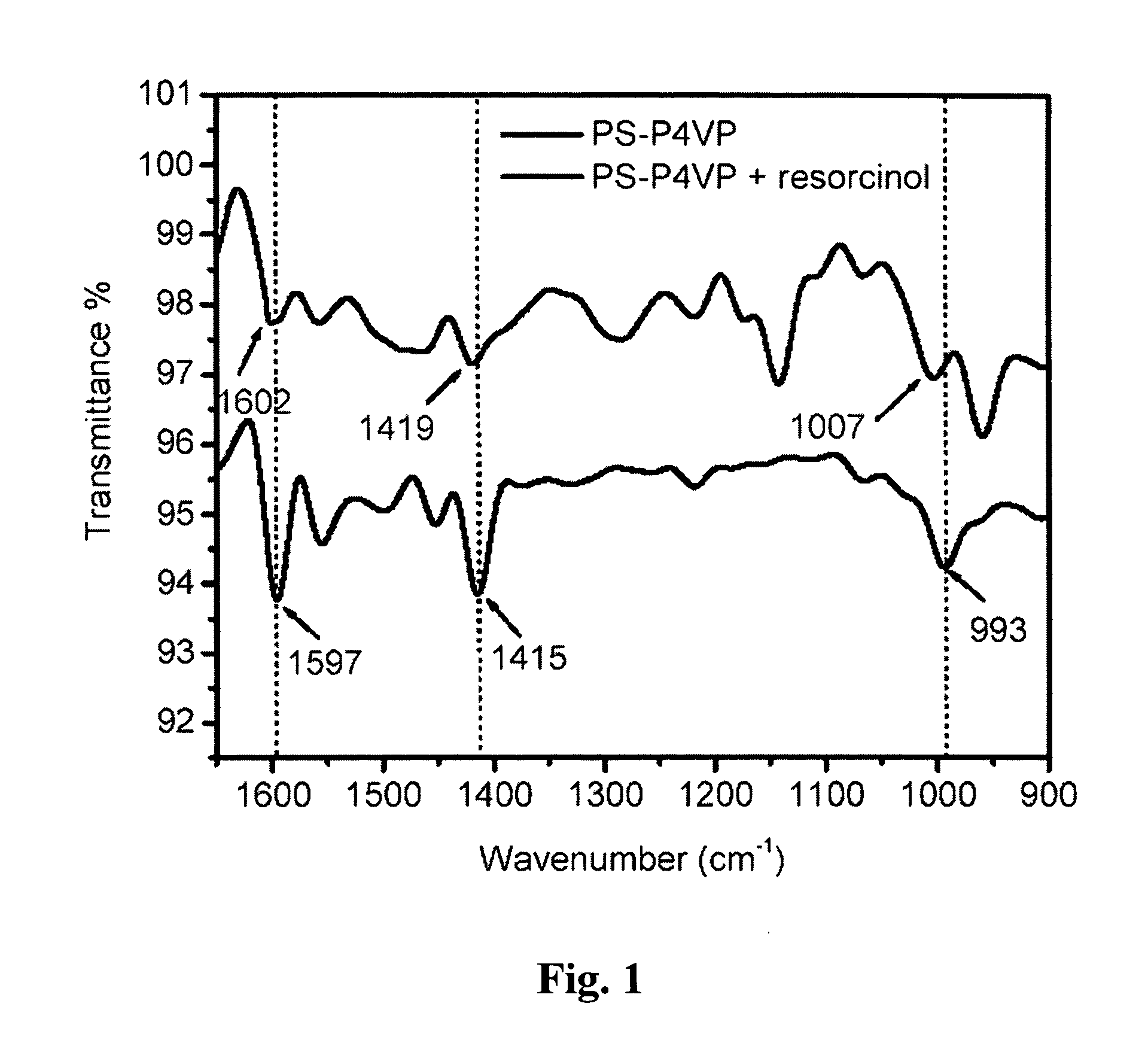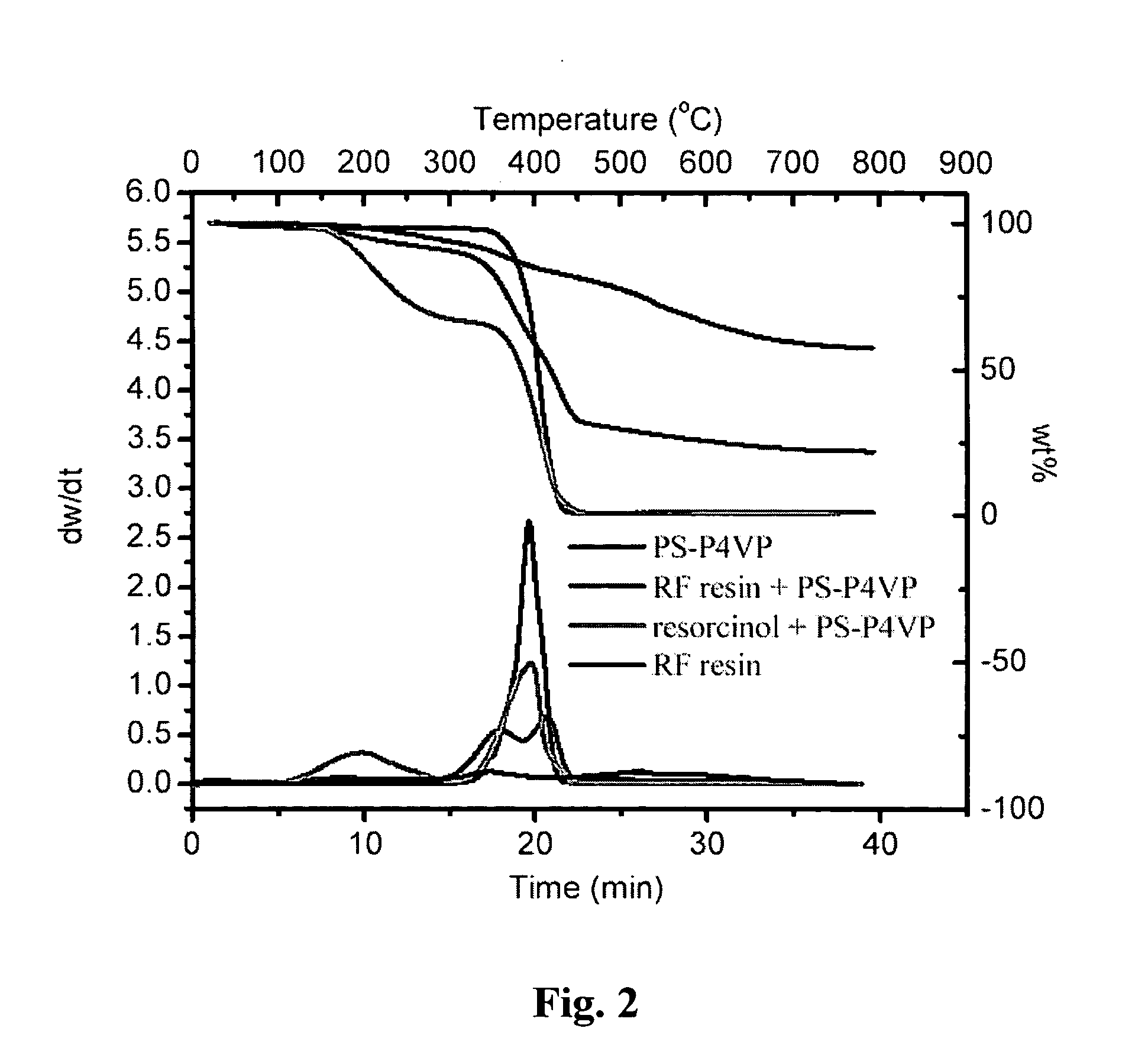Highly ordered porous carbon materials having well defined nanostructures and method of synthesis
a porous carbon material, well-defined technology, applied in the field of porous carbon materials, can solve the problems of inability to obtain ordered nanostructures by these methods, inability to adapt to the fabrication of large-scale ordered nanoporous films with controlled pore orientation, and wasteful procedures in the preparation and removal of inorganic templates
- Summary
- Abstract
- Description
- Claims
- Application Information
AI Technical Summary
Benefits of technology
Problems solved by technology
Method used
Image
Examples
example 1
[0031] Spatial organization of the phenolic resin monomer by block copolymers: Phenolic resin is used as carbon precursors. First, 0.1 g poly(styrene-block-(4-vinylpyridine)) (PS-P4VP), with average molecular masses (Mn) of PS 11,800 g / mol, P4VP 11,500 g / mol and Mw / Mn=1.04 for both blocks, and 0.0512 g resorcinol were dissolved in 2 g of dimethylformalamide (DMF). (Mw is the weight average molecular weight of the polymer. This solution was heated at 100° C. for 4 hours to ensure the formation of hydrogen bond. After the solution was cooled to room temperature, a drop of solution was cast into a film on a silica plate by spin coating at 1000 rpm for 2 minutes. The film was subsequently dried in a hood. The dry film along with 2 small vials which contain DMF and benzene, respectively, was then put into a preheated chamber at 80° C. The film remained in the chamber for 24 hours to allow the completion of microphase separation. The microphase separated film was dried in air and sequenti...
example 2
[0032] Spatial organization of polymerization catalyst by block copolymers: Poly furfural alcohol was employed as carbon precursor. 0.1 g poly(ethyleneoxide-block-propyleneoxide-block-ethyleneoxide) (PEO-PPO-PEO) triblock copolymer and 0.01 g p-toluenesulfonic acid were dissolved in 2 g tetrahydrofuran (THF). A film was cast by using this solution by dip coating at 40° C. The cast film was then annealed in THF vapor in a 24 hour period. The annealed film was thoroughly dried under vacuum and then exposed to furfural alcohol gas for about 30 minutes at room temperature. A black poly(furfuryl alcohol) was formed on the film. This film was stabilized at 100° C. overnight to ensure the completion of polymerization. The film was carbonized in nitrogen gas through a temperature ramp of 1° C. / min to 800° C.
example 3
[0033] Spatial organization of linear polymer via the self assembly of block copolymers: Neither catalyst nor monomer was used in this route. Poly(4-hydroxyl-styrene) was used as carbon precursor after it had been cross-linked with formaldehyde. 0.1 to 20 wt % of poly(styrene-block-4-hydroxyl-styrene) in THF was cast to substrates. The structure of the film was refined in the THF vapor for 24 hours. The film was then thoroughly dried in a vacuum oven at 50° C. The dry film was cross-linked in formaldehyde gas at 80° C. for 10 hours before it had been finally carbonized through a temperature ramp of 1° C. / min to 800° C. The carbonized film had an ordered nanostructure dependent upon the ratio of the two blocks. In general, with PS block in the range of less than 20 percent, the resulted carbon film has a cubic porous structure; PS block in the range of 20-40% yields hexagonal cylindrical pores; PS block in the range of 40-60% yield lamellar carbon sheets; PS block in the range of 60-...
PUM
| Property | Measurement | Unit |
|---|---|---|
| pore sizes | aaaaa | aaaaa |
| thickness | aaaaa | aaaaa |
| temperature | aaaaa | aaaaa |
Abstract
Description
Claims
Application Information
 Login to View More
Login to View More - R&D
- Intellectual Property
- Life Sciences
- Materials
- Tech Scout
- Unparalleled Data Quality
- Higher Quality Content
- 60% Fewer Hallucinations
Browse by: Latest US Patents, China's latest patents, Technical Efficacy Thesaurus, Application Domain, Technology Topic, Popular Technical Reports.
© 2025 PatSnap. All rights reserved.Legal|Privacy policy|Modern Slavery Act Transparency Statement|Sitemap|About US| Contact US: help@patsnap.com



